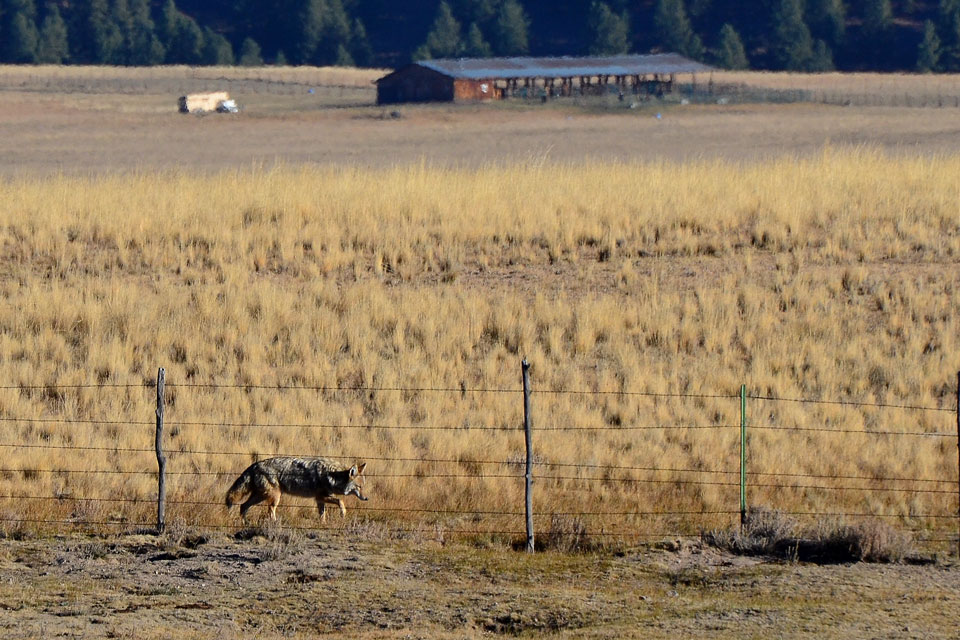Above photo: Coyote hunting prairie dogs by Larry Lamsa (CC BY 4.0)
By Darryl Fears
For years, the massive toll of wild animals exterminated by the federal government as a service to everything from airports to ranches has bounced up and down like a yo-yo. Last year it was up again.
The more than 4 million animals shot, poisoned, snared or trapped by the Department of Agriculture’s Wildlife Services in fiscal year 2013 included 75,326 coyotes, 866 bobcats, 528 river otters, 3,700 foxes, 12,186 prairie dogs, 973 red-tailed hawks, 419 black bears and at least three eagles, golden and bald.
Though there’s a list of animals killed, there’s little data showing the cause for each killing, the methods used and the reasons behind mistakes that lead to massive kills of animals that aren’t targeted.
At least two members of Congress have called Wildlife Services secret and opaque for failing to provide more information, and there are mounting calls for an investigation into how it operates.
Wildlife Services says that it responds to requests by government agencies nationwide and works to “resolve human/wildlife conflicts” in a strategic way. “As wildlife damage increases, requests for assistance also increase,” said spokeswoman Carol Bannerman. Ranchers and farmers pay half the agency’s costs of killing animals that they view as a threat.
In 2012, the USDA Wildlife Services reports the number of wild animals terminated, freed, released, relocated or dispersed. Here are the top 10 killed or euthanized.
But the agency provided no explanation for why the kill total can be 1.5 million in one year and 5 million the next. Near the turn of the century, it hit a staggering 4 million. Two years later, in 2001, it fell to about 1.5 million and stayed relatively low for six years. But in 2008, the number of kills rocketed to 5 million before trending downward to 3 million over the next four years. Now it’s back up, well past 4 million in the most recent count, and critics are pressing for a better explanation for why.
Wildlife Services’ primary purpose is to eradicate invasive creatures introduced from other parts of the world. They include greedy feral hogs, giant swamp rats called nutria, big aggressive Argentine lizards called tegus and swarms of hungry starlings that destroy the habitats of animals native to the United States.
But the agency also kills native animals en masse, sometimes based solely on a home-owner’s or farmer’s perception of a threat.
Birds that invade airports and swipe cattle feed at farms contribute to the high totals. Non-native European starlings, sparrows, pigeons and such accounted for 87 percent of animals killed. Birds in general are singled out as a nuisance. The rise in the number of exterminated animals came despite growing scrutiny and protest.
Last December, the Center for Biological Diversity filed a petition demanding that the agency explain the exact reasons why it makes each kill of a native animal, for whose benefit and the methods used. The petition called Wildlife Services “a rogue agency” that was “out of control.”
At the time, a Wildlife Services spokeswoman, Lyndsay Cole, responded that it kills birds at 800 airports nationwide so they won’t gum up the works of airplanes. Cole said the department kills some animals that are a threat to endangered animals. Other animals, such as raccoons, are eliminated as part of the National Rabies Management Program.
Cole said the agency is guided by a science-based decision-making model. For example, wolves are killed to “lessen the negative impacts of expanding wolf populations,” even though those populations are still recovering from earlier government programs that aimed to exterminate them.
Rep. Peter A. DeFazio (D-Ore.) has railed against the secret methods of Wildlife Services, at one time calling it “one of the most opaque and obstinate departments I’ve dealt with.” DeFazio has asked to know what goes into poisons used by the agency that are a danger to people and harmless animals but hasn’t gotten an answer. “We’re really not sure what they’re doing.”
Wildlife Services has been around under different government names for more than a century. It essentially cleared away wildlife for America’s westward expansion.
In a 2012 report, Wildlife Services relied on a National Agricultural Statistics Service survey to show that wildlife caused $944 million in agricultural damage in 2001.
Atwood dismissed the “science-based model” Cole mentioned as a document that “basically says they can use whatever methods at their disposal whenever they want.”
Her organization’s petition called on the USDA and the Obama administration to develop a policy based on ecological science, showing how removing animals from the wild affects the natural balance of the habitats.
In the Northeast, for example, the elimination of red wolves led to a proliferation of coyotes, which the wolves rarely tolerate in their range. Coyotes push away foxes, which prey on deer mice, which spread ticks.
The execution of wolves and other predators, such as bears, allows deer to proliferate across the country, destroying trees that serve as habitat for other animals.
Atwood described Wildlife Services’ work as “a staggering killing campaign, bankrolled by taxpayers” and happening “beyond the view of most Americans.”
Download the article here.

